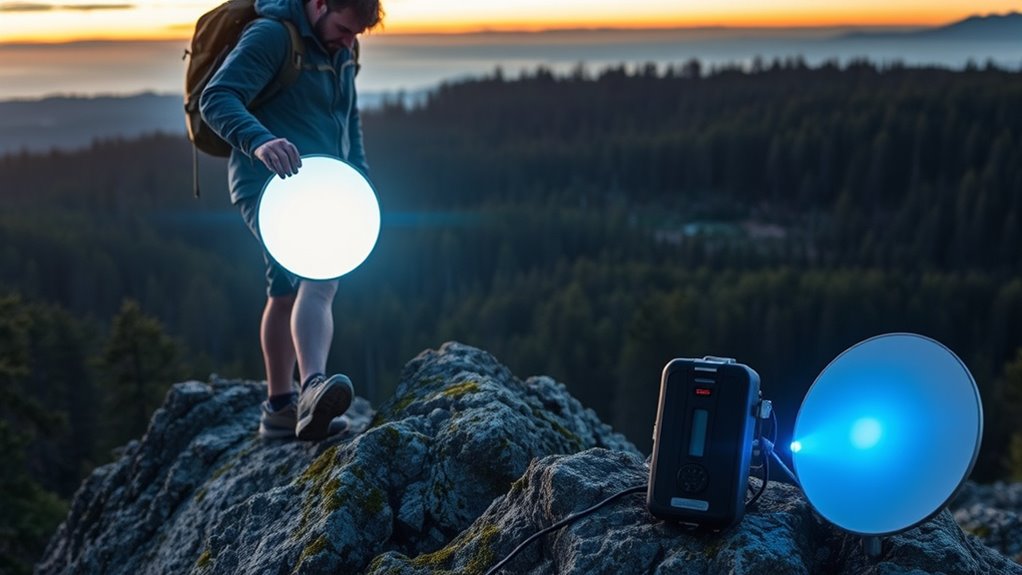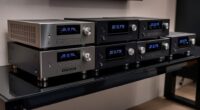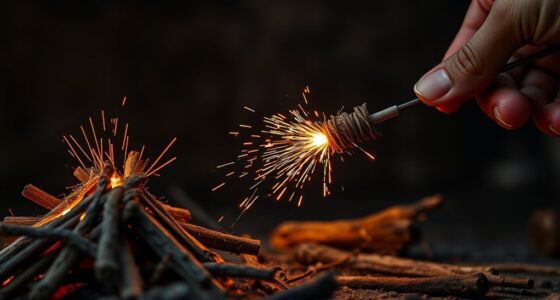When you’re off the grid, signaling like a pro can dramatically boost your chance of rescue. Use your vehicle’s hazard lights and emergency signals to catch attention, and blow your horn sparingly to alert nearby people. At night, flash a powerful flashlight or reflect sunlight with a mirror to attract rescuers. During the day, create visible markers or signs with bright clothing or rocks. Combining audio and visual signals can make all the difference—keep exploring to learn more effective techniques.
Key Takeaways
- Use a combination of visual signals like flashlights, mirrors, and daytime markers to attract attention effectively.
- Employ sound signals such as short, steady horn blasts or vehicle horns sparingly to alert nearby rescuers.
- Create large, recognizable ground markings like “SOS” or “HELP” with rocks, branches, or reflective materials for visibility.
- Turn on hazard lights or emergency signals on your vehicle to increase visibility, especially at night.
- Maximize environmental features, like reflecting sunlight with mirrors or using water to generate noise, to enhance signaling efforts.

Mastering the art of signaling can substantially improve your communication on the road, helping you drive more safely and confidently. Whether you’re navigating busy highways or exploring remote areas, clear signals are essential to alert others of your intentions and avoid accidents. When you’re off the grid, however, signaling takes on an even greater importance because standard vehicle lights and signals might not be enough to catch the attention of rescue teams or fellow travelers. Learning how to effectively signal in these situations can be the difference between being rescued quickly or remaining stranded.
Effective signaling is vital off the grid for safety and rescue.
In remote areas, your vehicle’s horn and lights are your primary tools for signaling. Use your horn sparingly to alert nearby individuals of your presence, especially if you’re in distress. A short, steady horn blast can alert someone to your location, but avoid excessive honking, which might cause confusion or annoyance. If you have a flashlight or a high-powered torch, use it to create visual signals, especially at night. Flashing your light repeatedly can draw attention from rescuers or passing vehicles. If you’re using a flashlight, keep it pointed and steady—pulsing or inconsistent signals might be ignored or misunderstood.
Another effective method involves using reflective objects or signaling devices, such as mirrors or reflective tape. If you have a mirror, position it to reflect sunlight toward potential rescuers or aircraft overhead. This technique, known as signaling with a mirror, is a classic and reliable method to catch someone’s eye from a distance. For daytime signaling, bright-colored clothing, flags, or even a tarp can serve as high-visibility markers. Spread these items on the ground or wave them to attract attention. Remember, the goal is to make yourself as visible as possible, especially in open terrain where your location might otherwise blend into the environment.
If you’re near a vehicle, turn on hazard lights to create a beacon visible from afar. If your vehicle has a distress or emergency signal button, activate it to send a clear message of distress. In some cases, creating a large, clear “HELP” or “SOS” sign on the ground using rocks, branches, or other materials might also help rescue teams spot you more easily. The key is to be consistent and deliberate with your signals, repeating them periodically to increase visibility.
Using a jet boat’s high-performance engine and its ability to operate in shallow waters can be a crucial advantage when signaling in remote aquatic environments, providing additional options for attracting attention from rescue teams or passing vessels.
Frequently Asked Questions
What Is the Most Reliable Emergency Signal Device for Off-Grid Rescue?
A PLB (Personal Locator Beacon) is the most reliable emergency signal device for off-grid rescue. It sends a GPS-enabled distress signal directly to rescue authorities, ensuring quick assistance. You activate it with a simple press, and it works globally, even in remote areas without cell service. Carrying a PLB gives you peace of mind, knowing that if trouble strikes, help can find you fast.
How Can I Improve My Chances of Being Rescued Without a Signal?
Think of your survival as a lighthouse in a storm—bright, steady, unmistakable. To improve your chances without a signal, stay visible by creating large, contrasting markers on open ground, like a giant “X” or a bright fire ring. Keep yourself dry, conserve energy, and stay patient. Your presence is a beacon, so remain calm and make yourself as noticeable as possible, guiding rescuers to your location like a lighthouse guides ships home.
Are There Specific Locations Better Suited for Setting up Rescue Signals?
Yes, you should choose open, elevated areas like hilltops or ridges for setting up rescue signals. These spots offer better visibility from the air and distant observers. Stay clear of dense forests or deep valleys, which can block signals. Use reflective materials like mirrors or foil, and create large, distinct signals such as SOS or arrows in clear, unobstructed spaces to catch attention quickly.
What Should I Do if My Communication Device Fails Completely?
What do you do if your communication device fails completely? First, stay calm and assess your surroundings. Use visual signals like mirror flashes, bright clothing, or ground-to-air signals to attract attention. If you have a whistle, blow it periodically. Remember, persistence pays off. Are you prepared to switch to these backup methods? By staying resourceful and alert, you increase your chances of being rescued even without your device working.
How Long Should I Wait Before Giving up on Rescue Efforts?
You should wait at least 24 to 48 hours before giving up on rescue efforts, especially if you’ve signaled consistently. During this time, keep making noise, using mirrors, or creating visible signals. If no rescue arrives within that window, reassess your situation, conserve energy, and consider moving to a more visible location if it improves your chances. Patience and persistence are key when waiting for help.
Conclusion
Remember, over 80% of rescue situations rely on effective signaling. By mastering simple techniques now, you boost your chances of being found quickly if you ever find yourself off the grid. Don’t underestimate the power of a mirror, a whistle, or even a flashlight. Stay prepared, stay visible, and keep practicing your signals. Being proactive can mean the difference between a long wait and rescue—so signal like a pro, whenever it counts.










